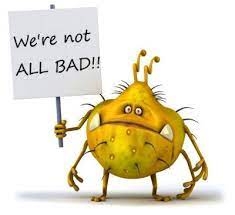Bacteria belong to the lowest category of plants. They are unicellular micro-organisms. They are  as small as 25,000th part of an inch. Some of them are even smaller and cannot be seen with the help of an ordinary microscope. They reproduce through the process of cell division (fission) i.e. one cell divides itself into two. Under favourable circumstances the rate of their reproduction increases. Within twenty minutes the cells of the new bacterium divide into two, in forty minutes one bacterium multiplies to four and to sixty four in two hours. In this way, in twenty-four hours, one bacterium multiplies into 4,000,000,000,000 bacteria. If the rate of the reproduction of bacteria remains the same, the weight of the bacteria produced within 72 hours will become 33,000 times more than the weight of the earth. But this is impossible because in the struggle for food and water only one percent of them can survive. They may live in soil, water, air or in any other organisms.
as small as 25,000th part of an inch. Some of them are even smaller and cannot be seen with the help of an ordinary microscope. They reproduce through the process of cell division (fission) i.e. one cell divides itself into two. Under favourable circumstances the rate of their reproduction increases. Within twenty minutes the cells of the new bacterium divide into two, in forty minutes one bacterium multiplies to four and to sixty four in two hours. In this way, in twenty-four hours, one bacterium multiplies into 4,000,000,000,000 bacteria. If the rate of the reproduction of bacteria remains the same, the weight of the bacteria produced within 72 hours will become 33,000 times more than the weight of the earth. But this is impossible because in the struggle for food and water only one percent of them can survive. They may live in soil, water, air or in any other organisms.
Bacteria can be broadly classified into four types. Some bacteria are round, they are called coccus. The rod-shaped are called bacillus, spiral-shaped the spirillum and the comma-shaped vibrio.
Bacteria are both harmful and useful. They spread many diseases in human beings, animals and plants. Typhoid, tetanus, T.B., cholera, diphtheria, dysentery, whooping cough etc. are some of the well-known diseases which are spread by bacteria. But, on the other hand, some bacteria are very useful for mankind. Conversion of milk into curd is done by bacteria. They destroy the dead plants and animals by setting decay in them. Vinegar is also prepared by them. It is the bacteria which make yeast for bread, and colours the hides (animal skin). Certain antibiotics are also prepared by using them. Thus, bacteria are both useful and harmful to us. Antibiotics and sulpha drugs are used to control bacterial diseases.

